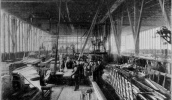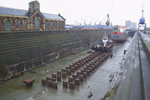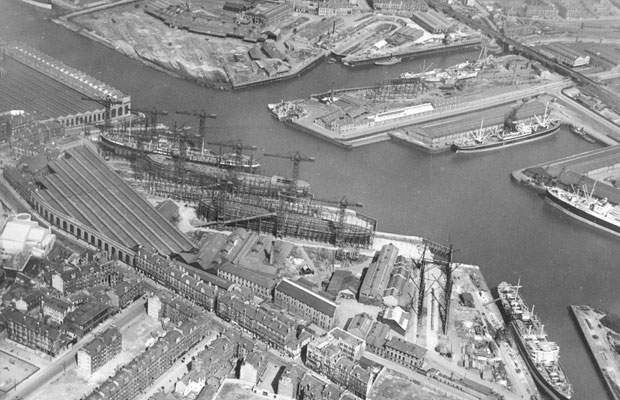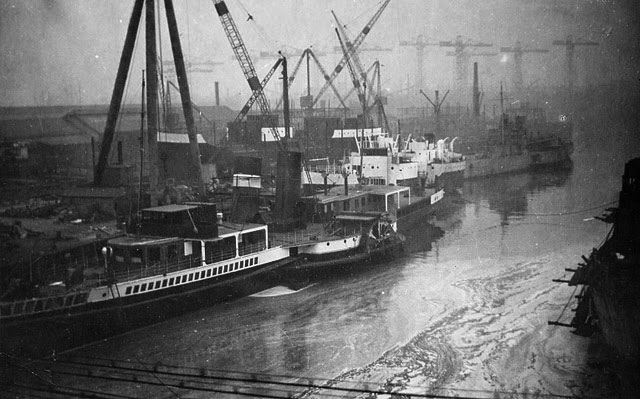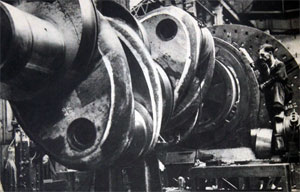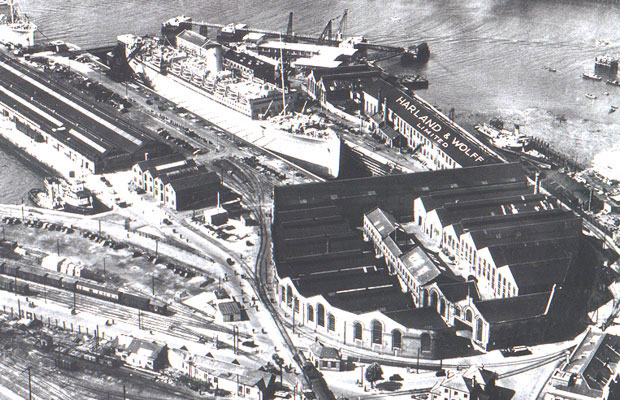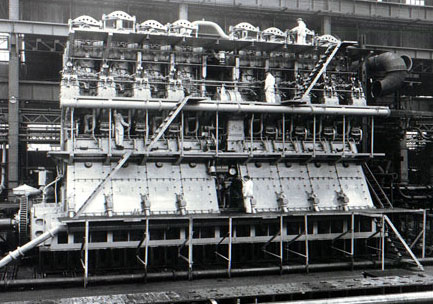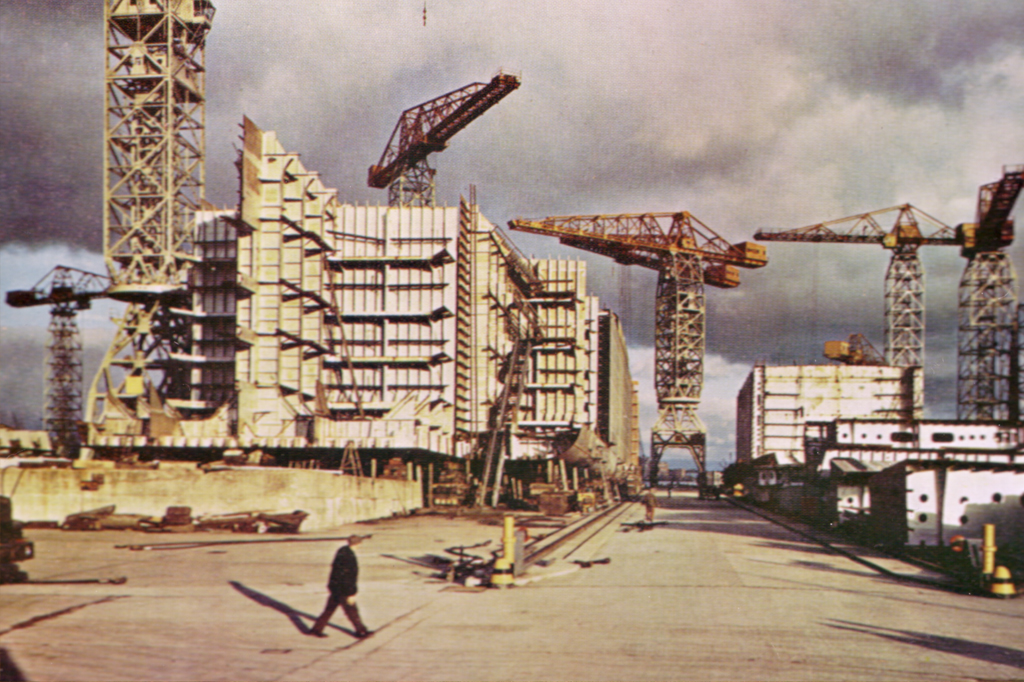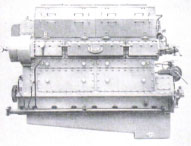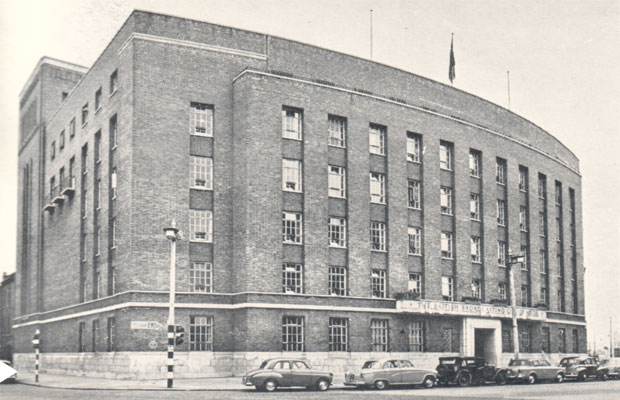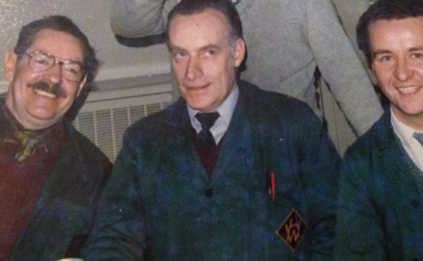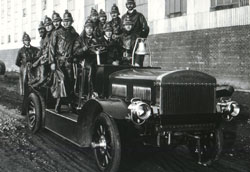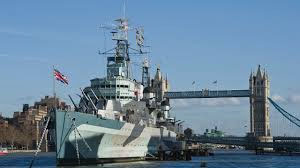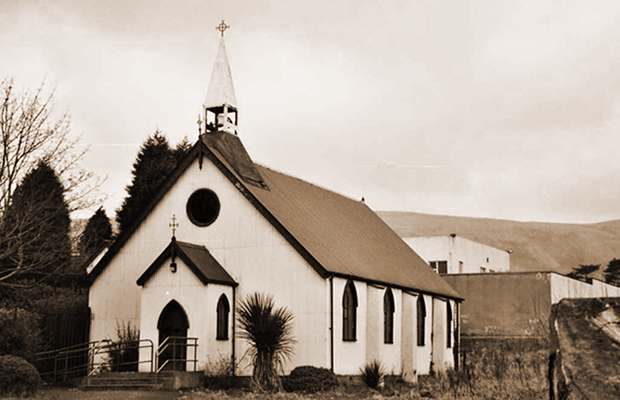DIESEL ENGINES FOR RAILWAY TRACTION
Two types of H & W Diesel engines were specially developed for rail traction service. A 2-stroke type designated by the letters PR and a 4-stroke type by the letters RL.

H & W Shunting Locomotive in Ulster Transport service. Powered by 615 PR type engine. Mechanical drive and hydraulic torque converter.
2-Stroke Diesel Engines for Railway Traction
The 2-cycle series PR type were made in two sizes with maximum revolutions 1,200 and 800 r.p.m. respectively. These engines were robust compact units having weight factors averaging about 18 to 25lb/ B.H.P. suitable for main-line and branch-line service.
DESCRIPTION
These engines which were the outcome of much experience of Diesel rail traction both at home and abroad, are of the vertical trunk type with airless injection, arranged with uniflow scavenge. Scavenge air is delivered by a rotary boiler and reaches the cylinders through rows of scavenge ports uncovered by the pistons. Exhaust is effected through four small exhaust valves in each cylinder cover. This arrangement gives excellent scavenge, permitting a brake mean pressure comparable with that of a 4-stroke engine.
The valve gear is light and comparatively quiet, and the main tenance of valves and valve gear correspondingly light. The arrangement also permits of a single central fuel injector for each cylinder.
This series of engines were developed specifically for rail traction service and every detail had been considered from the point of view of robustness and trouble-free operation without attention on the road.
4-Stroke Diesel Engines for Railway Traction
The 4-stroke engines denoted by RL were made in a single cylinder size with revolutions from 500 to 700r.p.m. and have a weight factor of 50 to 6o lb. /B.H.P., which is too high for general rail traction purposes, but quite suitable for shunters. These engines were developed for shunting purposes on the basis of a conservative design of industrial and ships auxiliary engine. They brought with them, therefore, the advantages of moderate rating and low maintenance costs. They could be supplied for operation with atmospheric induction or pressure induction by means of exhaust turbo-chargers.
DESCRIPTION
These engines are of the critical trunk type with airless injection, designed for continuous service with low maintenance.
No attempt had been made to cut down weights to a minimum and the keynotes are simplicity and accessibility combined with a conservatively rated engine. The heads are of the 4-valve type. i.e.. There are two inlet and two exhaust valves per cylinder: an arrangement which increases the breathing capacity of the engine and is conducive to quiet shock-free running of the valve gear and long life of exhaust valves between top overhaul.
All bearings below the cylinder tops are forced lubricated, the bearings on the cylinder tops themselves being grease lubricated needle bearings requiring a minimum of attention.
These engines could be supplied for operation with atmospheric induction or pressure induction by means of exhaust turbo-chargers.
Right - Works Shunter powered by 15 PR type 2-Stroke engine. 4-Speed S.L.M. Gear Box.
Left - “Silver City Comet” (NS.W. Railway) operating regular service between Parkes and Broken Hill (422 miles) at approximate speed of 50 m.p.h. Powered by two 815 PR engines with Voith-Sinclair turbo-converter. Five railcars for this system were similarly powered.
Right - Canadian Pacific Railcar - CPR 7000 diesel locomotive was a custom built one-of-a-kind unit never repeated, using imported components from British Empire countries to avoid heavy Customs duties. Ordered in 1935 from Stone Franklin of Canada Ltd, Montreal it was built by National Steel Car Co. Hamilton using a 6cyl. 600HP diesel from Harland & Wolff.

|
|
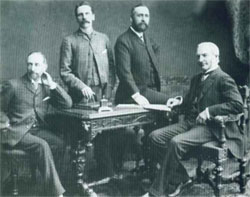 The PartnersHarland, Wolff, Pirrie and Wilson
The PartnersHarland, Wolff, Pirrie and Wilson
 The HatsChairmen, MD's, CEO's
The HatsChairmen, MD's, CEO's
 Sir Frederick RebbeckChairman 1930-41 1944-62
Sir Frederick RebbeckChairman 1930-41 1944-62
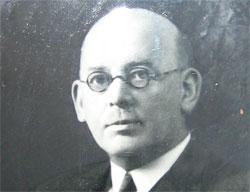 Sir Charles PalmourChairman 1941-1944
Sir Charles PalmourChairman 1941-1944
 John S BallieChairman 1962-1965
John S BallieChairman 1962-1965
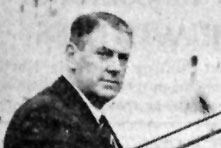 Dr Dennis RebbeckChairman 1965-1966
Dr Dennis RebbeckChairman 1965-1966
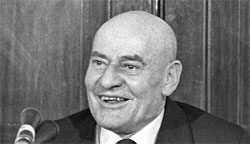 Sir John MallabarChairman 1966-1970
Sir John MallabarChairman 1966-1970
 Joe R EdwardsChairman 1970
Joe R EdwardsChairman 1970
 Alan WattActing Chairman 1970-1971
Alan WattActing Chairman 1970-1971
 Lord RochdaleChairman 1971- 1975
Lord RochdaleChairman 1971- 1975
 Sir Brian MortonChairman 1975-1980
Sir Brian MortonChairman 1975-1980
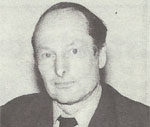 Victor Alexander CookeChairman 1980-1981)
Victor Alexander CookeChairman 1980-1981)
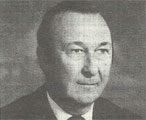 Vivian WadsworthChairman 1981-1982
Vivian WadsworthChairman 1981-1982
 Sir John ParkerChairman 1982-1992
Sir John ParkerChairman 1982-1992
 Islandmen(and Women)
Islandmen(and Women)
 Save our ShipyardSupport and solidarity
Save our ShipyardSupport and solidarity
 The War MemorialsWe Will Remember Them
The War MemorialsWe Will Remember Them
 The Bible Class
The Bible Class
 Nicknames
Nicknames
 The Yarns(and Tall Tales)
The Yarns(and Tall Tales)
 The Shipyard IndentureJW Mullholland
The Shipyard IndentureJW Mullholland

